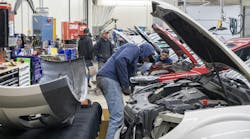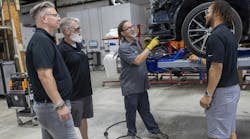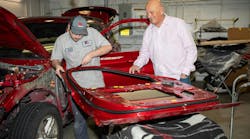Kevin Muir says he was well aware of the steep competition his shop, Nanuet Collision Center in Monsey, N.Y., faced.
“There are a lot of body shops around and what differentiates one from another?” he says. “It’s the quality of work they do and putting a face to a name.”
Looking for a way to get his face out there and make personal contact with current and potential business partners in his company, Muir turned to outside sales.
By definition, outside sales refers to going out in the field to conduct visits to potential customers in hopes of building a relationship.
“For an insurance agent to have that relationship with a body shop owner, to know who they are, what their ethics are and how they like to take care of people, it’s a win-win,” Muir says.
And according to Philipp Lomboy, founder of Marami Marketing Group, which frequently works with collision repair shops on their marketing campaigns, those connections are vital to a business’s success.
“It’s cultivating relationships where you’d be able to get referrals from these folks,” he says.
And while the process is relatively simple, Lomboy says there are a few critical steps to getting it right. Lomboy, Muir and Domenic Nardini, vice president of sales and marketing at Classic Coachwork in Virginia, break down the seven steps to mastering outside sales visits.
1. Identify Marketing Targets. Lomboy says that while one-on-one interactions are one of the most effective ways to drive traffic, they are not exactly scalable.
“There are a lot of potential partners you can go with, but you only have a small staff you can do that with,” he says.
That’s why identifying marketing targets is such an important step of the outside sales marketing process. He recommends outlining your shop’s market reach and then identifying the various partners or businesses you could market to.
“You have to ask, ‘Who can I really lend value to?”’ Lomboy says. “These are people who have access to customers that you ultimately want. It’s a matter of identifying what it is about them that you can affect.”
While insurance agents are an obvious choice, Nardini says he also targets fleet accounts, valet companies, corporations, golf courses, and most importantly, dealerships.
“I felt it would behoove us all if we concentrated on dealerships that don’t have their own body shop and make relationships with those dealerships,” he says. “In the day we live in, if someone gets hit, they’re calling the salesperson of where they bought their car.”
Lomboy says to narrow down your targets, do some research and rank their potential impact on the business. For Nardini, he says dealership referrals make up 60–70 percent of Classic Coachwork’s business.
2. Create a Schedule. Determine how often you plan to visit each business and set up a schedule or route. Since the visits are fairly casual, Nardini says it’s not necessary to set up formal appointments. The key, he says, is consistently visiting the businesses when you say you will.
Nardini visits his marketing targets on a weekly basis, but Muir says his visits are conducted on a monthly basis.
Nardini recommends asking the individual if you can stop in on a weekly basis, and depending on their answer, adjusting your schedule accordingly.
3. Designate someone to carry out the assignment. Nardini notes that deciding who should be in charge of the outside sales visit can be a difficult decision.
“Unfortunately there are a lot of entities that can’t solely put a salesperson in place, simply because they’re not big enough and they can’t designate a person to generate sales and leads,” he says.
Nardini was hired as vice president of sales and marketing at Classic Coachwork when the MSO was at six locations and looking to grow. The company had never had an outside sales program and was looking for an expert to come in and develop the program for the shop.
Muir, on the other hand, started out conducting the sales visits himself.
“You find out who you’re dealing with and if there’s a problem, they know who to call,” he says.
While Muir handled the visits for more than 10 years, he says he recently became too busy and hired a marketing company that focuses on outside sales visits.
“I reached out and found someone in my area that’s his specialty,” he says. “I met with him and he’s a very personable guy who knows the industry. I’ll do a review with him, tell him some of the things we’ve done over the past month and direct him where I want him to go.”
4. Create branded materials. Nardini says it’s important to bring along materials that will ensure your shop is easily remembered. He recommends bringing branded pens, post-it notes, vouchers and posters.
In particular, he brings branded 24”x38” framed poster signs for the service department and visitors lounge of every dealership the shop works with. The posters are branded for Classic Coachwork (and contain the shop’s basic information and locations), as well as the dealership’s logo.
Nardini says the materials are inexpensive and easy to create, but are effective at helping the shop remain top of mind.
For valet companies and other corporations, he brings along wind signs with similar information and other materials that can be hung or placed in a visible area.
“I basically put our logo and brand everywhere I can,” he says.
5. Build a friendly presentation. Nardini says the presentation should be relaxed and casual. “If I’m going on a first visit, I’m just going in educating them: This is who we are, this is what we do, this is our brand and this is how we can help you,” he says. “I’m not trying to get their business up front. I’m there to show my face.”
Nardini says to follow that up by asking if you can stop in weekly to say hi.
“If they’re interested, they’ll start asking questions. If they’re not, I’ll just ask if it’s OK to come in from time to time. Now you’ve established trust and they can count on seeing you all the time,” he says.
The subsequent visits require simply stopping in, reminding the business that you’re there to help and getting to know them.
“The more they see you, the more they get to know you, and eventually, the more they feel the need to help you out,” Nardini says.
6. Educate the Partner. Muir says a good way to open doors during sales visits is to bring a printout of your shop’s CSI scores along.
“It shows that we monitor our customer’s perception of who we are and their satisfaction level,” he says. “I explain that we do this follow-up and here’s where we stand in the market.”
He says he leaves a copy with the partner every three to six months. If an agent refers a client, he also pulls the CSI report for that customer specifically, to demonstrate how the client was treated.
Nardini says a selling point for him while building a relationship with the dealer is showing how it’s a mutually beneficial relationship.
“For example, if it’s a Honda dealership, we don’t have any relationships with a Honda dealership. So if someone was going to be exclusive to us, we would give them all our Honda parts business for all eight locations,” he says. “I educate the sales folks. I’ll make up vouchers and tell them we feel it’s best to control the customer at the point of sale. That way you’re controlling where you’re ordering the parts from.”
Lomboy says it’s important to explain the value of partnering with your shop.
“What are you offering to them? A lot of times, salespeople are me-centric and ultimately you have to stop that,” he says. “What is it they want? For example, maybe an insurance broker wants to look like a trusted provider for their clients or stand out from the competition. How can I affect that?”
To do that, Muir says he makes it a point to explain his shop’s brand promise to illustrate how his shop could become a trusted partner for the insurance agent.
7. Consistency is key. It takes time to not only cultivate the relationship, but also get the returns from it. It’s important to be consistent in your follow-up visits and stick to the promised schedule.
“They want to know that they can trust you,” Lomboy says. “Once you’re able to get in, you have to find out what the next step is. Timing is not always going to be great for you and the referral source. You have to be prepared to communicate with them in the same way six months down the line.”
Nadini says that even though it can be a long road, the consistency will pay off.
“You have to be in front of the right person during the right time,” he says. “It took me from 2011 to February 2014 to start working with one BMW dealership. From all that hard work of going in weekly and saying we’re here to help, it finally paid off. Now they send us consistently 30 cars a month.”



